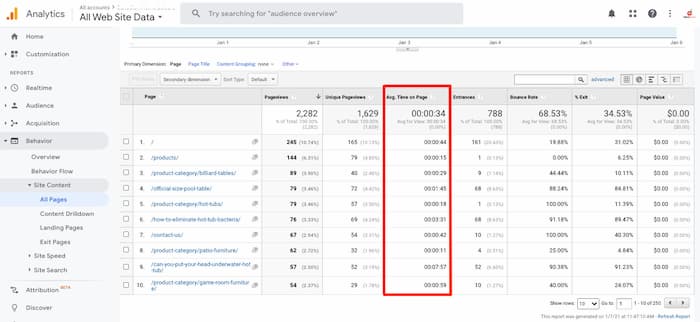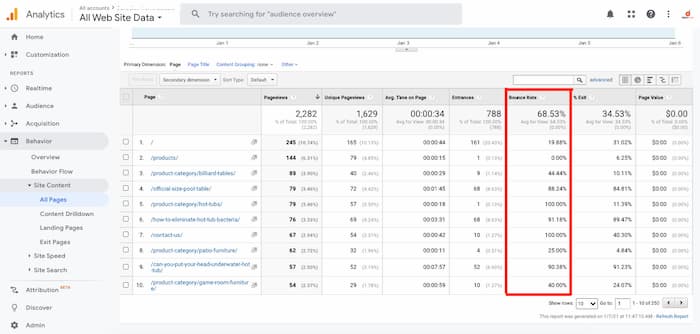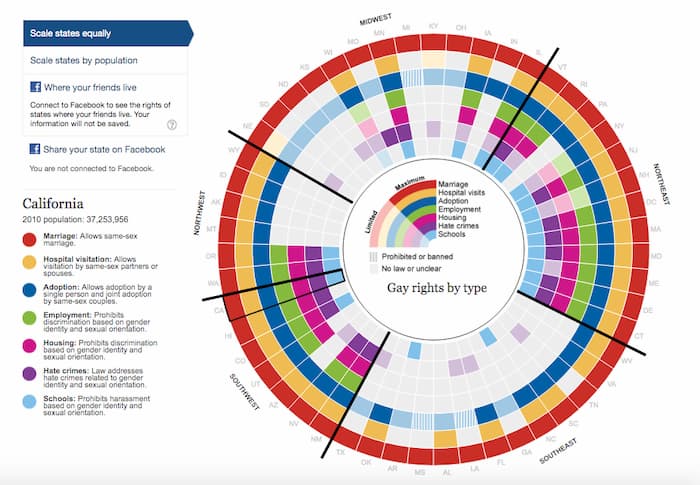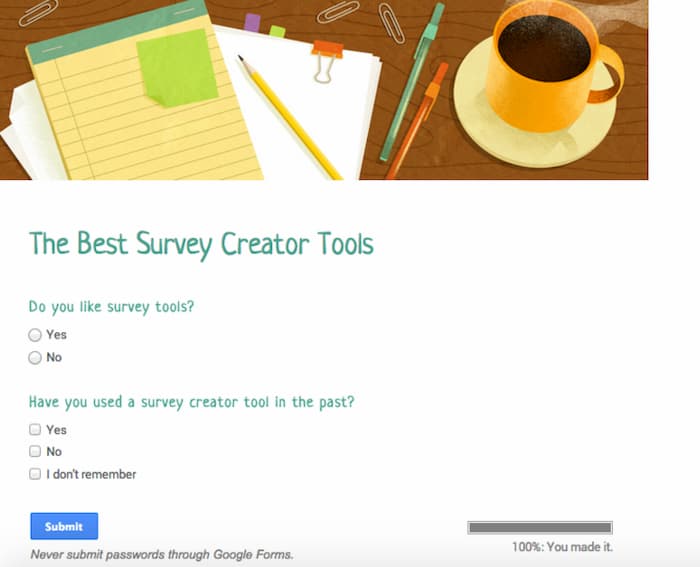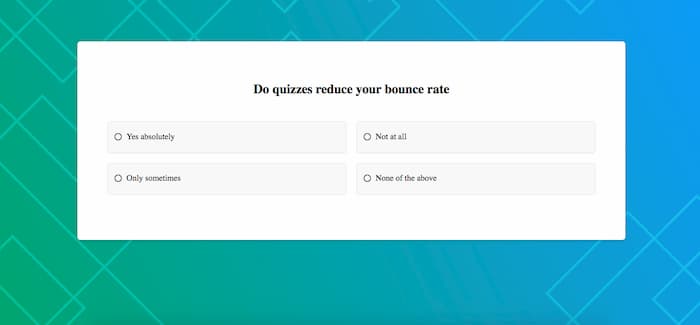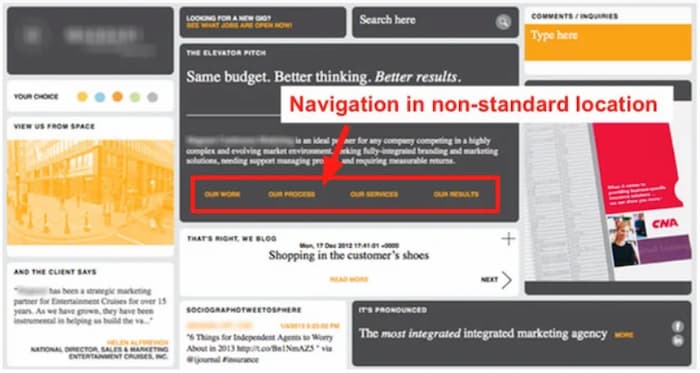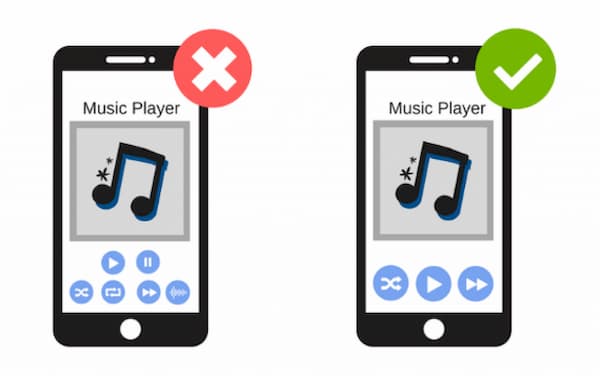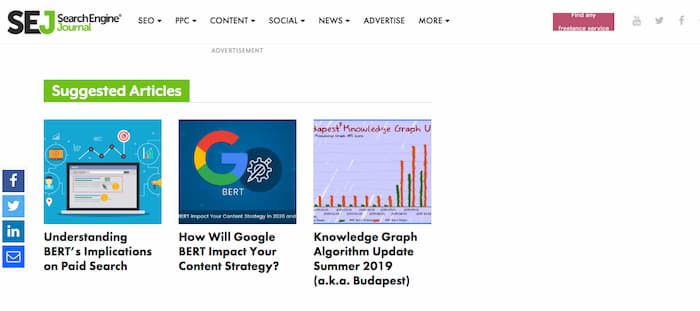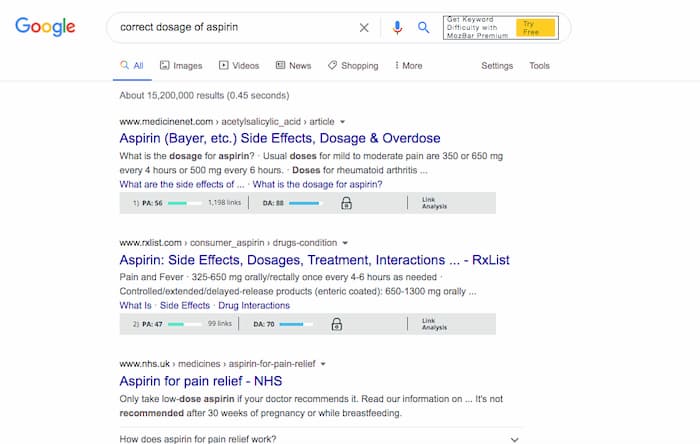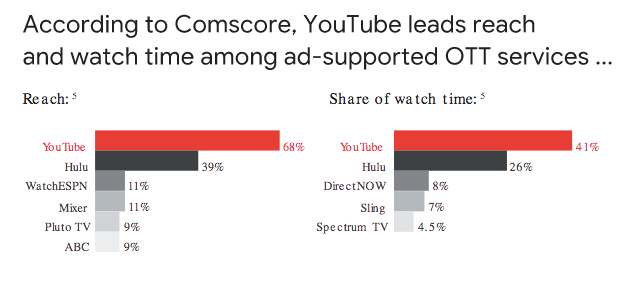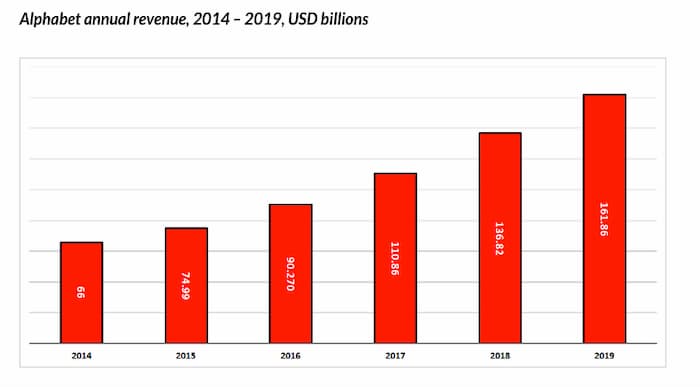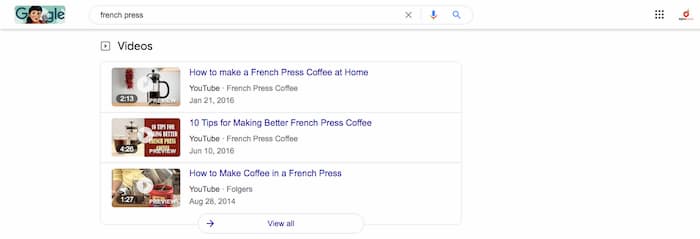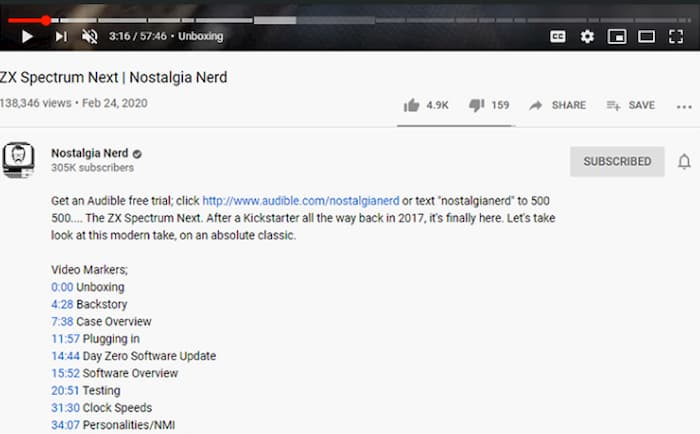9 Ways To Reduce Your Bounce Rate & Improve Traffic Quality
Of all the ways to increase traffic to your website, it’s not often that you think of the source of new visitors as being from the traffic you’re already receiving. There’s a hidden trove of visitors you can unlock by using several tactics to reduce your bounce rate.
What is a bounce rate?
The bounce rate on your site is the total percentage of visitors that land on your site and leave without interacting with any other pages or links. This is a metric that’s reported in your Analytics and a value that can be crucial in improving the quality of traffic your website receives.
You can find the bounce rate of the pages of your website in Google Analytics by clicking on Behavior,
Used in the right context, this metric can identify problems on your website that may be causing people to leave.
A high bounce rate can potentially indicate a missed opportunity since visitors are already on your page and yet leave without completing a goal such as making a purchase or signing up to an email list.
Related reading: Key Performance Indicators & Data Analysis
What’s a good bounce rate?
A good bounce rate can be different on a situational basis. Many site managers would maintain that a bounce rate of over 60% warrants attention. Others are happy if their bounce rates are under 80% and yet this could be a catastrophic number to another website.
The percentage of a good bounce rate depends on the niche in which you’re competing and the type of page that’s generating your data.
So where is the happy medium for your website?
Your bounce rate should be assessed in light of the goal you have for the user on the page you’re analyzing.
You also need to accurately determine the behaviour of your audience to understand the meaning of the data being generated.
Aim to see the bigger picture
The problem with using bounce rate alone is that it doesn’t give you the entire story of what’s happening on your website. In the words of Dan Shewen,
[bctt tweet="No metric is an island on its own."]
If a user lands on your page and reads every single drop of a 5000-word article, then leaves, it would technically register as a bounce. If 80% of users did the same thing, the first glance at your analytics might tell you visitors do not like your content-which, in reality, this is not the case.
This brings us to the first point…
#1- Reference the average time spent on page
To accurately determine the true meaning of bounce rate on a specific page, you need to compare it to the average time spent on the page. In the example above, the bounce rate alone is a misleading metric without cross-referencing the average time spent on a page.
Significance of longer averages
By recognizing that each user spends 5-8 minutes on your page before leaving paints a more accurate picture of how users are engaging with your content. You can’t be certain that your content is the problem judging from just the bounce rate and not referencing the average time on the page.
If people are spending a long time on your page, it means they’re getting through your content. Consider creating a conversion goal, call to action or offer more options for related content to get them clicking through your site (discussed further in this article).
Significance of shorter averages
A short time spent on your page could mean users aren’t liking what they or they aren’t getting there because your page takes too long to load. If the average time spent on your page is short and you have a high bounce rate, you need to make changes. Users are landing on your page and not even giving it a chance.
Significance of no time on spent on page
If the page in question shows no time spent, the user might have closed the tabs or the browser to end the session on your page. If this happens, there is no time recorded because there is no exit click.
The average time on a page is measured from the entrance click to the exit click. If your users don’t click on anything and close the tabs you have some slightly misleading data being generated.
#2- Establish a CTA or conversion goal for your page
Content alone is not enough to keep visitors from leaving your page. Establish a clear and concise call to action for each of your pages to keep your audience engaged and moving through your website.
Ask visitors to share your content
Are you trying to build a stronger social presence? Ask your visitors to share your article with their social networks. Social sharing plugins are effective and offer a simple click to share option, making it easy for readers to click on the icon and share with their audience.
Ask visitors to join your email list
Present your readers with more opportunities to join your email list.
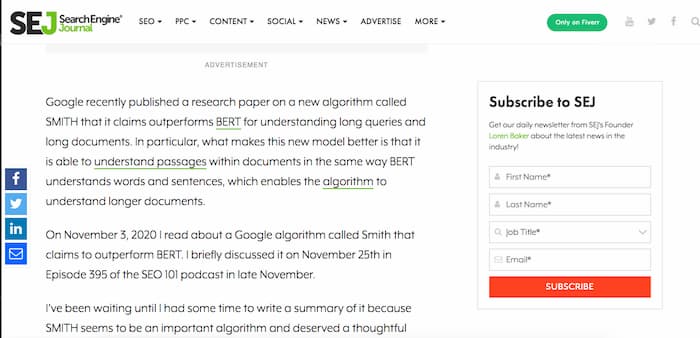
Include a CTA a few times within your post, which can be on the opt-in form itself.
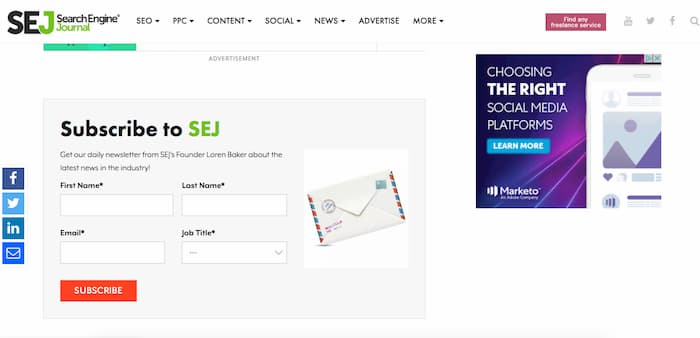
Create conversions on Google Analytics
Ultimately we want our website visitors to purchase a product or service from our business. Creating goal conversions tracks whether your audience is doing what you want them to do on each page.
Whether it’s a sale, email sign-up form, or a social share, track your goal conversions. When your visitors start clicking on the links you want them to, it eliminates the session from becoming a bounce.
#3- Use interactive content
In the case where users are landing on your pages and leaving almost immediately, you will need to consider updating the content on the page. Interactive content is a solution to get your audience more engaged with your page and improving the stickiness it has for captivating their interest.
It’s a proven fact that people learn more when they are engaged with hands-on learning as opposed to just reading or listening. Interactive content allows your users to elevate the learning curve and retain more information. By getting your visitors to engage with any of several different content assets, you can reduce the bounce rate of your pages.
Interactive infographics
Infographics may have seen their height in popularity, but they are beneficial for both B2B and B2C sales and marketing. Visual content itself is proven to improve retention from 10% with plain text to 65% with an image. Interactive infographics boost information retention to the next level by allowing the user to interact with the graphic.
Here is an example of an interactive infographic that shows you information on the gay rights of each state in the US.
Whichever state you hover over with the mouse will highlight the information from that state on the sidebar.
Surveys
Surveys are proven to be one of the most popular forms of content. Incorporate a survey within your content to get your visitors engaged.
You can choose from some of the most popular survey tools as a starter for testing out your audience’s response.
Polls
Inserting polls within your content also gives your audience a fun way to answer questions and compare their answers to past visitors.
Inserting a poll in your content can provide a good break-in text and get your visitor to actively participate and engage with your content.
Pop quizzes
What better way to reinforce the content your visitor has just read than a pop quiz? The response from your audience may vary (some people don’t like to be tested!) but again, it’s a good way to make an option for a user to step outside of the mundane practice of reading and participate in a potentially enjoyable experience.
You can use sites like quiz maker or better yet, Jotform’s Quiz Maker to create and publish pop quizzes in your content.
Click to tweet
Inserting tweets a click to tweet call to action is a simple way for your audience to tweet a message or something worth sharing on your site. The amount of effort required for a user to click on the link makes sharing super simple.
This type of embed serves as a way to break up the text, get your users interacting with what you’re saying and contributes to increasing your audience.
#4- Re-optimize for user intent
When a visitor lands on your page, you have a few seconds before they decide whether your page can satisfy their search intent. Re-optimize your content to enhance your page’s ability to satisfy the user’s intent.
"Give the people what the people want."
The adage, “SEO is ever-changing” applies here when it comes to updating old content. Search intent is constantly in flux and going over old content can reveal out-dated articles that need to be re-optimized for current keywords as well as new ones.
SEO is not static with regards to the fact that at its core, it is based on user intent. People are always changing the way they search for things as well as the language they use to search. It can pay off in dividends to go over old content to make sure that your content satisfies user intent.
Improving the quality of your content and making sure it’s up to speed with the competition improves traffic and will reduce your bounce rate.
#5- Simplify your website navigation and searchability
One of the most common reasons users leave a website is because it’s not easy to navigate. When a visitor lands on a site for a specific reason, they need to believe that your website can satisfy their search. It’s important to provide easy access to all of your important pages so users can find what they’re looking for.
Even if they don’t see what they want at first glance, give them your best options to entice them to click further as well as a search box to search the website for something specific.
Avoid confusing menus and heavily cluttered pages. The actions a user takes on your site should be intuitive and laid out for the easiest and simplest understanding.
Use communicative image icons and a simple navigation bar to encourage more clicks. Think of using the signpost analogy to guide users in the right direction. Drivers need to see signs that communicate clearly what direction they want to take.
Simplify everything and when you’ve got some results and feedback, simplify it again. The easier your site is to navigate the better the UX experience is, which contributes to a reduced bounce rate.
#6- Reduce the time it takes your pages to load
Page speed is talked about repeatedly in almost every SEO article but it’s mentioned for good reason. Google reports that for every second it takes your pages to load you risk losing more visitors.
Some websites have more to gain by improving page speed. If your website is experiencing load times over 10 seconds you have a big opportunity to optimize your page speed to 5 seconds and cut your bounce rates in half.
The result would be the same as doubling your traffic when you consider that you’re now getting the visitors that choose your site already but would never make it with slow loading pages.
#7- Optimize for mobile screens
If you’re not optimized for mobile screens, you risk visitors leaving your site. Reduce your bounce rate by making sure your website is easy to navigate with a layout that’s easy to use on all mobile screens.
Have you ever tried to use the desktop version of a website on a smaller screen?
When users are forced to “pinch” the screen to zoom in and out to read text or use buttons it’s considered to be a poor user experience. This can cause visitors to flee in search of a website that better accommodates their screen size.
Apart from reducing your bounce rate, you may also get a boost in traffic if you’re able to improve your mobile-friendliness. Don’t forget that Google indexes the mobile version of websites before the desktop version.
You can test your website’s mobile-friendliness on the mobile-friendly test site or directly from the SERP.
#8-Link to related content within your website
Use a topical internal linking strategy to provide links to other content within your site that a user may be interested in reading. Not only does this optimize your pages, but also you can lead users to different areas of your site for continued learning and discovery.
If the page your visitor lands on has zero links on it, where would your users go next? The only way out is backwards which registers as a bounce.
Offer related reading within your content and at the end to encourage a higher click-through rate and reduce your bounce rate.
#9- Write long-form content
The advantage of being an engaging writer is that the more you write, the longer people stay on your page! Long-form content also gives you more opportunity to link to related content and direct traffic to product pages and other important pages on your site.
When compared to short-form content, the long-form gets visitors to stay on your site longer and reduce your bounce rate.
Increase traffic with a reduced bounce rate
Reducing the bounce rate on your site could be the key to unlocking a significant percentage of traffic that you already receive. In many cases, the bounce rate represents users that find your website but never make it to see a single scrap of your content.
Deducing the reason for a high bounce rate on your site is a priority that you can’t afford to ignore. Fixing the underlying cause can result in higher user engagement, increased click-through rates and more conversions.
As the competition becomes stiffer and the organic click-through rate dwindles, finding ways to improve the quality of your traffic will be a key element for sustainable growth and increased revenue.
If you have any questions about how to reduce your bounce rate, feel free to contact us for complimentary website analysis and learn how we can help through using custom SEO services.
How Does The Google E.A.T. Algorithm Impact SEO?
Search engines display web pages based on multiple ranking factors and specific set criteria defined within its algorithm which changes with every query. The underlying criteria for assessing quality is based on the Search Quality Evaluator Guidelines that was published in 2013. The guide defines the principles behind the Google E.A.T. algorithm which continues to play a more integral part in Google’s ranking system.
What is E.A.T. in SEO?
E.A.T. is an acronym that stands for Expertise, Authority and Trust. A page that can demonstrate these qualities at a high level is considered to be of high quality. Understanding how to demonstrate these qualities to Google and other search engines can improve your website’s search visibility.
Expertise
This aspect refers to the author’s experience or credentials and how it contributes to their expertise on the topic being published. Expertise can be defined as awards, occupation, experience or accomplishments that are relevant to the topic of the main content.
Authority
The authoritativeness refers to how recognized the website or author is in their field. Do others mention them in the same niche? Are they well-known within their industry and considered to demonstrate thought leadership?
Trust
How well can the website be trusted? Does the website provide security for safe browsing or give a user the confidence to input personal information? Trust signal refers to the means for providing a user with security when browsing the website or interacting with the website.
These three attributes of a web page combine to form the basic principles of E.A.T. and the foundation of assessing the quality of a page.
Why is E.A.T. important?
A search engine function is to display the best solution to a search query. It should come as no surprise that part of this function is to filter out low-quality results and only display high-quality results. To make your website displayed frequently for important search terms to your business, your website needs to communicate the E.A.T. principles where they are most appropriate.
As search engines become better at applying the many different variables that make up a quality web page, the E.A.T. principles will have more impact on your website’s search visibility. Improving these attributes will contribute to higher rankings from increased traffic generation and ultimately increased streams of revenue.
Who does E.A.T. affect?
Technically, the E.A.T. principles affect every website, although it plays a much bigger role in the search visibility of some website over others.
Website’s with subjective content
For example, if a query is made on worlds cutest pets, E.A.T. won’t play as big a role in the search algorithm because the topic is fairly subjective. There isn’t as great a demand placed on a website to prove expertise, authority or trust when providing subjective or entertaining content compared to something that could impact a person’s life.
Does E.A.T. still, play a role in search visibility for subjective content? The short answer is yes. There is still the matter of providing a safe browsing experience and even backlinks that will affect ranking (trust and authority). In this example, however, expertise isn’t really a factor as much as the content itself and how users perceive its value.
Website’s with objective content
When a search is for a recommended dosage of a type of drug, then it becomes a more serious topic. The answer requires a specific level of expertise in order to be reliable and safe instructions for people to follow.
Search engines don’t want to display a search result that could potentially have false or misleading information that could potentially harm someone.
Websites that affect Your Money Your Life (YMYL websites)
Google rolled out the Medic Update in 2018 specifically to target websites that publish content with the potential to impact people’s lives seriously. These sites were referred to as YMYL websites (Your Money, Your Life). The result of the update was devastating for YMYL websites that did not demonstrate the E.A.T. principles.
Below is an example of a website that lost more than 50% of its traffic because it did not demonstrate the proper E.A.T. required for a blog that published health related content.
You can read more about how this website not only recovered its traffic but gained much more by applying the principles to match the Google E.A.T. algorithm.
YMYL websites publish content on topics such as health, finances and any information that affects the well-being of a person’s life. Articles that offer a recommended dosage-even with something as simple as aspirin is now a topic that can only be answered by a doctor.
Here is a search result for the phrase correct dosage of aspirin in which not a single website is listed that doesn’t demonstrate high levels of expertise and authority.
Offering a solution on how to reduce your debt or improve your credit is another topic that should only be published by a professional. Misleading information published on this content could potentially cripple a person financially. The Medic Update now requires searches regarding financial advice to be backed by experts and professionals.
The principles of E.A.T. affect all websites, although there are different degrees in which it affects a websites search visibility
How is E.A.T. applied to ranking?
The Search Quality Evaluation Guidelines outline the specifics on how the quality of a web page is determined. This guide provides a basic structure for what is required to meet the needs of the user and offers examples of web pages in different niches that demonstrate high E.A.T.
The problem
Although E.A.T. has been around since 2013, Google and other search engines struggled with a way of applying these principles within their algorithm. Many of these concepts are fundamentally human making it difficult to create an algorithm that could accurately assess content by applying the same concepts.
The solution
Google’s solution was to create many smaller algorithms tailored to specific niches that could identify the specifics of what was deemed quality.
Once the engineers have a potential change they want to implement, they will show the results to a team of quality raters both with and without the changes to the algorithm. The team is not informed on which set of search results is from the new algorithm.
The raters will then provide positive or negative feedback on the new algorithm search results. If the reviews were positive from the new tweak to the algorithm, Google will implement the change.
How do you improve the E.A.T. of your website?
Keep in mind that every niche may have a different set of values that impact ranking more than another. There are a set of guidelines that are outlined clearly in the search quality evaluator guidelines.
The key to understanding what’s most important is to think of the user first and what would make their experience better. Here are a few of the general practices that will contribute to a higher E.A.T. rating for your website.
Communicate expertise
If your website deals with YMYL content, there is no option but to prove what credentials and expertise the author of the content has in their field.
Publish a detailed About page
For example, if you are the only author on your website that deals with medical advice, you will need to have a strong About page that states your qualifications.
Tell users and search engines why you’re qualified to write about the content you’re publishing by stating your degrees, years in the industry, name of your practice.
List your achievements, awards and notable accomplishments or acknowledgements by other credible sources. Publishing these types of details signals to search engines that you have the expertise required to publish this type of information.
The same holds true for other websites in every niche. The example used in the Quality Search Guidelines uses the About page from a fish and chips restaurant as an example of a small business web page showing high E.A.T.
Hire experts or invite guest authors
Best practice to get the most E.A.T. would be to hire experts whenever possible. Have professionals publish content on topics they are qualified to write about. This provides credibility to the content as well as your website.
Provide author bios
Include a section to communicate the expertise of your author. This is the area that you can show users and search engines that your content is written by a professional and boost the E.A.T. signals of your website.
Build authority with high quality backlinks and mentions
Authoritativeness is mostly measured by the quality of backlinks and mentions of your website. This has always been a major ranking factor-since the beginning of Google. This concept is more easily understood through the “voting” analogy.
Aim for a high number of votes of credibility
A backlink or mention of your website by other quality websites are votes of confidence. When you accumulate a high number of votes (compared to your competitors) you’re considered an authority in your niche.
Target websites that are considered high authority
The only difference in this analogy is that unlike the concept of voting some votes count for more than others. Improving the backlink profile of your website creates authority. Strive to acquire quality backlinks from websites that are credible and have authority themselves.
Google is more efficient at determining a quality backlink now more than ever. This is and will be a main ranking factor far into the foreseeable future.
Inspire trust
You can improve the trust signals of your website by creating a safe and reliable user experience. The level of trust that you need to demonstrate depends on the type of industry you’re in.
Provide basic trust signals
For example, if you’re in ecommerce, it goes without saying that if your site doesn’t have the basics like an SSL certificate, you’ve already lost an easy trust signal.
Providing secure methods of payment such as using safe and trusted companies like PayPal or Moneris is also another way to make users feel secure with entering payment information while on your website.
Publish detailed contact pages
The contact information your website displays is also considered a way of inspiring trust. When a user is considering a product or service, your accessibility and customer service may play a role in their purchase decision.
A website that has an email address and a contact form does not inspire trust, compared to a dedicated customer service line available 24/7. This would be important for products or services where people need to feel more secure about the type of assistance they’ll get if something goes wrong.
If customer service is a major component to your product or service, providing adequate and detailed contact information will improve the trust signals of your website.
Add structured data markup
Use structured data markup to implement Schema and communicate to search engines any information you want to be highlighted. The added markup contributes to the knowledge graph and connects your website to other web properties/entities to provide additional trust signals.
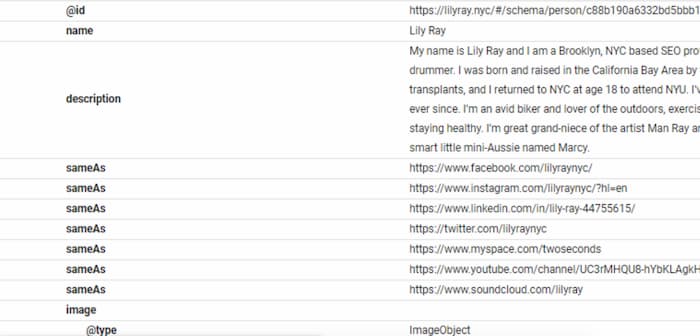
Structure your site for users
Link to your about and contact pages from the navigation bar or footer of your website to make these pages easily found. Structure your website in a way that users can find everything they need to build confidence in your brand.
What’s good for users is also good for search engines. They are and forever will be linked. Websites that provide a high level of user experience are rewarded with high search engine rankings.
At the end of the day, search engines want what’s best for the user. If you can identify what those things are in your niche, you’re able to apply the most accurate principles that satisfy the Google EAT algorithm and positively impact your search visibility.
Video Content Marketing Trends In 2021
The age of video marketing is upon us and in full swing. We’ve already witnessed the rise of video, which can be seen in YouTube’s rapid growth over the last few years.
There are dozens of ways to use video as part of your marketing strategy for 2021 and finding the angle will definitely contribute to additional traffic, conversions and a larger bottom line. Read about the video content marketing trends that are taking the world by storm and which you can capitalize on in 2021.
Ephemeral content
By definition, ephemeral content expires within a certain time period. The angle is to play on the user’s FOMO (fear of missing out) in order to elicit an immediate response or action. This type of content is being used more and more by marketers because of its effectiveness in getting attention. Stories have increased the time users spend on social media from 15-32 minutes a day.
For those who are dabbling in the world of influencer marketing, ephemeral content can be a less expensive way to get your content in front of an influencer’s audience. Many influencers on Instagram for example, will charge less for a story (that lasts 24 hours) than an actual post on their profile.
Ephemeral content provides an accurate way of measuring the impact of an influencer’s audience. The short bursts of increases in traffic and conversions can be attributed to the influencer campaign, giving investors more accurate insight into the value of influencer marketing.
Webinars
As a growing form of video marketing Webinars provide an effective method of educating an audience while providing a personalized touch (in your live stream events). Communication webinars have a conversion rate of 67%.
This marketing tool combines the concept of building authority and the confidence of your audience by educating them about a specific topic. Many webinars aim to sell products focus on showing their audience how to solve a specific problem using their product. With a first hand glimpse at what the product can do, there’s a much higher likelihood that users will buy the product.
Webinars can be extremely informative and therefore repurposed into more bite-sized chunks of content to include in your marketing campaigns.
The best webinar software allows you to schedule users to watch the replay multiple times throughout the day to continue driving traffic and generating leads.
Google search results
If you’ve been paying attention, you may have noticed an increase in the number of videos that appear in the search results. Apart from the fact that Google owns YouTube (which means 95% of the videos are YouTube videos), there is a growing demand for video content that Google is supplying wherever possible.
Videos are appearing in searches in which the underlying user intent may be satisfied with a video. Take product searches for example. Many times a video will appear as a product review or a video on how to use the product.
Considering the fact that entire business models are built on YouTube traffic suggests that there is a massive opportunity. The first-page position on Google, as well as a high-ranking position on YouTube, can contribute to massive traffic to a website or conversion page.
There is evidence that incorporating a video on web pages will also contribute to a higher ranking on Google.
How to capitalize on more traffic from video
Obviously, creating a video is your first step. Many companies are under the impression that it takes a large investment to create a video content marketing campaign. Bentley proved this theory wrong by shooting an entire promotion with an iPhone.
Optimize your videos for SEO
Although a video has the potential to go viral or be shared enough to drive a substantial amount of traffic, optimizing your video can get your content in front of a targeted audience.
Use the basic rules of on-page optimization by including your keyword in the title, filename, description and tags.
Take your video SEO to the next level by publishing a transcript of your video within the description. The more information you give search engines about what’s on your video, the more keywords your video can appear for in searches.
Include chapters to increase appearances for video snippets
A simple way to segment your video into pieces is to create chapters. Write out the times on your video that represents where topics change or where questions are answered in order for search engines to pick up on your snippet.
Simply include the segments of your video in the description with a time next to each chapter.
YouTube will pick up on the markings and segment the progress bar into the different pieces of content that you’ve highlighted.
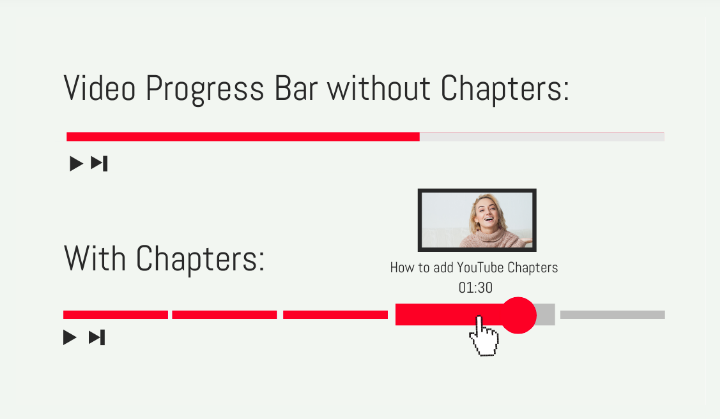
This results in providing search engines with more accurate information that can be highlighted for appropriate search queries. The segmentation of video content creates smaller snippets of specific information that is shown more frequently in keyword-related searches.
The reach of OTT
Video streaming has already been a major movement that has caused many families to switch from cable to streaming platforms. It is estimated that 87% of families now stream to their televisions and of those, 70% no longer use cable.
YouTube is one of the largest platforms with far-reaching implications. If you’re going to advertise using a PPC campaign, it’s an obvious choice to consider. The challenge becomes being able to target your ads and make sure it’s reaching an appropriate audience.
Video marketing trends are too big to ignore
The world is changing, as we know it. Video has provided us with an easy way of creating content and is now the preferred method of content consumption. With the numbers continuing to rise, it’s obvious that if you’re not including video content marketing in your overall marketing strategy, you’re leaving a lot of money on the table.
Look to use the most appropriate video content marketing trends that apply to your business. The effort you put in now will only contribute to higher margins, more leads and increased revenue.

